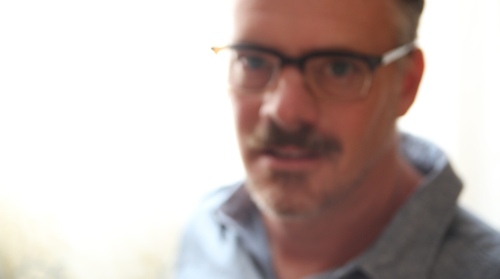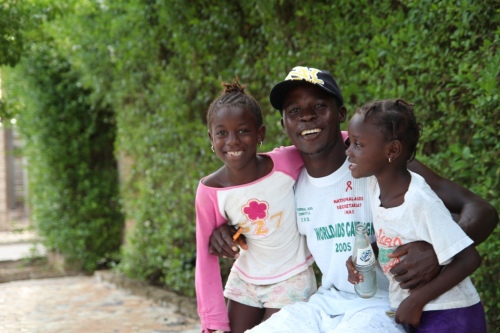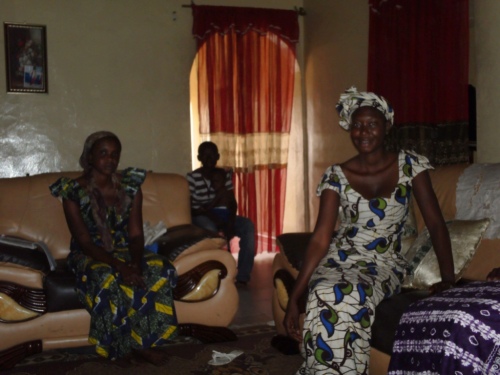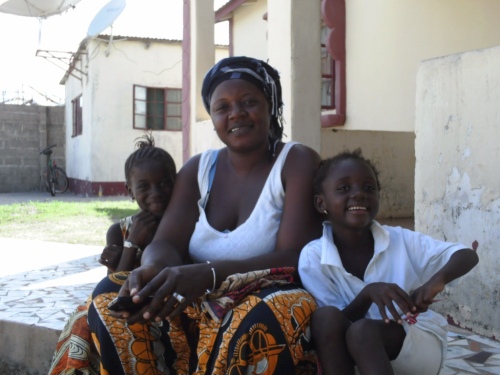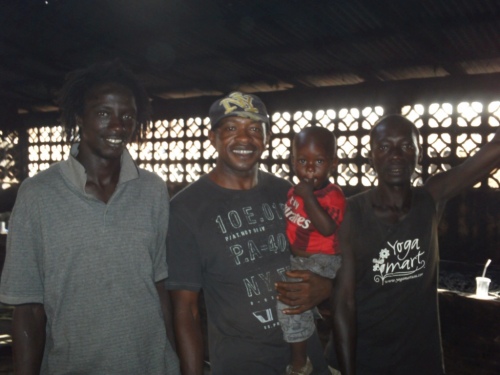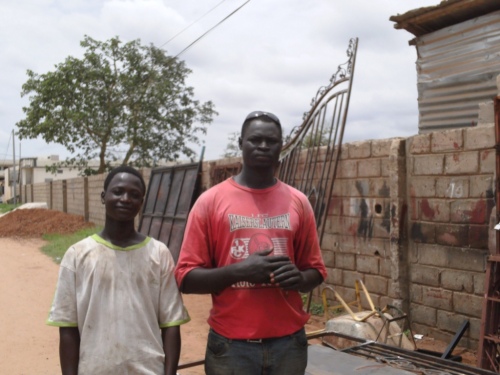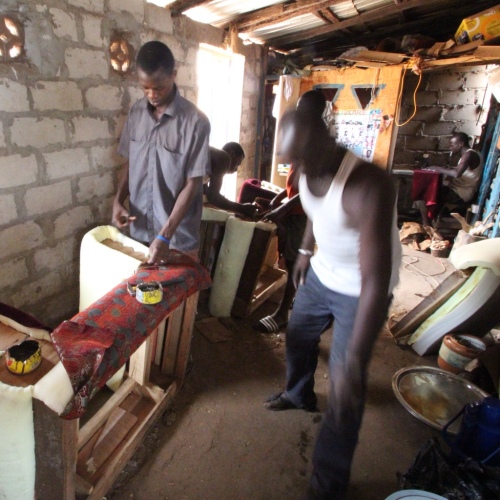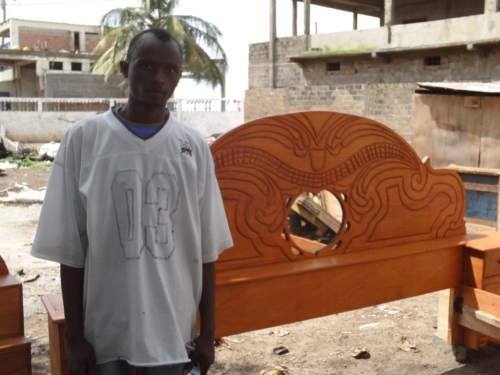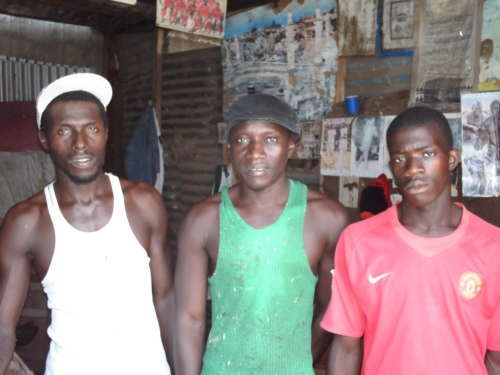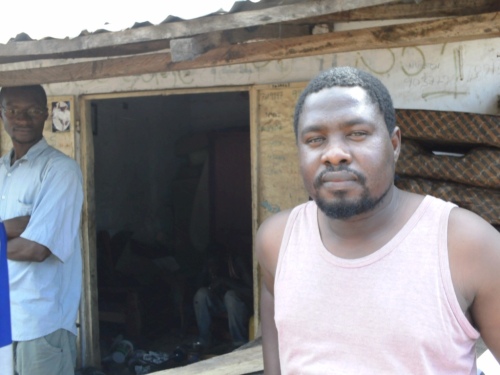Carpenters – Half Die, Banjul
This was the first set of carpenters I spoke with – I have an earlier post about them. They were the first people I spoke with about buildings, design, and craftsmanship, and I should have been more thorough and gotten their names. Luckily, I was more thorough in future visits with others people. They, like everyone, had me photograph the photographs they had of their work. At first I thought I was doing this to be polite as they showed me their work, but now I realize that I have a great record of the work of these craftsmen.
In this image they are working on a suite of upholstered parlor furniture. The frames are plywood, and the final product will take a bulbous overstuffed art deco meets 80s era “pleather ” form. (I am working on a more academic description, but I think I make my point.) These suites are usually four chairs and one large sofa, all with rolled arms and usually some wooden detail at the arm front. I saw them in many homes, and of various quality. These will have a plush fabric upholstery which you can see being sown in the back ground.
This is not a Polaroid. It is one of my DSLR images.
Modou Bah – Albert Market, Banjul
A few days after I first met some the carpenters above, I decided to meet a few more. I am much more comfortable meeting people now, and I think I learn more because of it. Modou did not have a market stall, rather a large open work area where he was able to make a number of pieces of furniture at one as well as display. I could not decipher if the large area was to this benefit, or if his lack of a stall was a detriment. I gathered that it was half a dozen of one and six of the other.
My time with Modou, with the help of Alieu, helped me to see that many researchers might focus more on the ethnographic story at hand than I did. And although I did find that Modou was Fula, had been working in the market for ten years, had trained as an apprentice, and was training a few of his own, I was more interested in the work he was completing and how he was completing it. I got great pictures from his set of sample photos, and I got a good explanation of the different materials he used and the styles he preferred, the heart motif you see here is common throughout the Gambia, as is the bulbous rococo style.
Modou works in plywood, keno, and mahogany. I got some great video of Modou carving a plywood pattern, and most of the work he had around was clear stained plywood as shown in this picture. Keno is a local hardwood that has a wide variety of tones from very light to a dark warm brown. It seems too varied to my eye, but local craftsmen comment on the beauty of it whenever asked to describe it.
Every carpenter I met was an independent business man, and they shared their phone numbers with me. I agreed to share them. Modou’s number is 9118903. :).

Agibou Jallow – Albert Market, Banjul
You can see here that Agibou and I hit it off. He was enthusiastic about his work and spoke of his love of the craft and the freedom being carpenter gave him from management and a fixed schedule. Of everyone I spoke with he seemed to be the most of an artisan. He worked alone in a small stall and was working on a pattern for a bed when I arrived. He explained that he is often hired to just draw the carving pattern either by clients directly or other carpenters.
Agibou was Fula like Modou, but it was explained to me here that tribe and trade are not strongly linked.
Agibou was also working on a parlor suite in a style I found frequitly, but not as common as the overstuffed deco suites. These suites are very rectilinear, and some examples appear almost like knock-offs of craftsmen Morris chairs. I think it more a matter of the pragmatics of assembly than a direct reference, but there is much research to be done on that I am sure. It is clear to me that these craftsman style pieces are falling out of fashion; you will see complete sets with the upholstery or cushions removed piled up as scrap wood. They are typically mahogany, which is expensive in The Gambia comparative to other materials, but still a common site. It is also a common site to see mahogany being sawn for making fishing boats, construction lumber, or large chords being put in containers for export to China and India. There seems to be no controls regarding deforestation, a concern for many Gambian intellectuals.
Agibou, though, was working in pine for this specific suite. This seemed strange to me, and we had a great conversation about pine and it’s workability and color. When I explained that where I lived in the U.S. I was surrounded by pine forests his eyes lit up like mine did when I first saw all of the mahogany lying around in The Gambia. We shared that irony with a laugh. Pine is imported and while not a precious luxury, it has a price on par with mahogany. People like it for the knotted texture and variation of color. Agibou and I got another good laugh when I said that was considered “common” in the U.S., and he said the same of the dark consistant color of mahogany. Pine is considered a fine finish wood in The Gambia, and you can see it being used to trim atound around rough carpentry and structural mahogany.
Agibou’s numbers are 9943081 and 7943081.
Ibrahem Singnathi – Albert Market, Banjul
Albert Market is the main market of Banjul. It sits atop an area know as Wolof Town. Wolof Town and Half Die are separated by Banjul’s central axis from the colonial areas of Portuguese Town and New Town. (many of the colonial trading companies working in English administer Gambia were Portuguese.) The central axis is Rene Blain Street around which is flanked by a narrow area called soldier town. The plan of the city is similar in shape to a boomerang, Rene Blain is the short line of symmetry while the colonial and indeginous/Creole areas form the swept back wings. For those who know New Orleans, it is hard not to see a direct comparison to Canal Street and its dividing of the American sectors from the French Quarter and Creole faubourgs. Along with Janjangbureh, this is one of the few Gambian examples of the black/white division seen more frequently in American colonies.
Albert Market is at the black shoulder of the boomerang and is a center of activity for the entire city. It is a place for merchants to squeeze a penny out of customers even though the market sellers seemed to have friendly relations with each other. When you interview people in West Africa, it is appropriate to leave people with a token of your appreciation, and these Polaroids have been wonderfull expressions of thanks. But I have also been giving small informant fees ($1-3) at the close of my interviews. The fees are not an obligation, but they are not a surprise to my interviewees either. I think, though, the news that toubab was handing out money for carpenters had gotten around, and Ibrahem was enthusiastic to show me his stall. He explained that he had two apprentices (in the right of this photo) and had been working for thirteen years. I did not see any work underway, but there was a lot of mahogany craftsmen style components about. I asked what hours he work, and he explained that sometimes he works all day, other times he does nothing and lays about … “the African way.”
“The African way” is a term that I hear frequently. It is usually used to describe lazing about waiting for something to do for reasons of beurocracy or lack of opportunity. Many people seem to use it with irony describing their own situation. One young man told me that he can spend a day reading for his own intelectual development, studying for comprehensive exams, then just sitting under a tree …, “you know, the African way.” Other people use it, I hypothesize, to explain marijuana use, but frank conversations about this, like many vices in West Africa, are difficult.
Sainey Jallow – Brikama, Kombo North
Brikama is listed as The Gambia’s third largest city behind Banjul and Serekunda (considered the coastal urban centers) but most Gambian’s will tell you it is larger than Banjul. It is also geographically large; the first major city outside of the coastal urban centers, but many Gambian’s describe Brikama as quickly, if not already, becoming part of the urban core.
Space is certainly one of the main traits of Brikama, and has taken a little acculturation for me to recognize this. Shops are often individual, although spaced by only a yard or two, and the shops are larger. Sainey’s shops was large to my eye, although he demurred to agree with me. He had eight apprentices and reported steady growth in his business since he opened in 2006. Unlike many of the carpenters I spoke with, he volunteered that he completed grade twelve, and he employed many young highschoolers who would become carpenters after completing school. All of Sainey’s, and every carpenter I met, apprentices were male.
It is hard not to make the American parallel of Banjul as decaying urban core, Serekunda as a congested first ring, and Brikama as a sprawling, unyoked and soon to boom outer ring.
Sainey showed me his work in plywood and keno. He had a few beds about that had the trademark keno striking variation between dark and light grains. Sainey also showed me work he did in maligna. Maligna is an indeginous soft wood similar to pine which the carpenters generally refer to as “white wood.” Maligna is affordable, and used for all applications, but it is not resilient to termites like mahogany or keno, and it does not have the desired preferred “richness” of grain that pine does.
Tucked away in Sainey’s shop was a hand carved keno door. It was detailed, intricate, and seemed to have references to traditional West African wood carvings. It was completed for one of the tourist lodges in near by Makasutu Culture Forest. I documented it, but I found through this conversation and others that the traditional wood carving was limited to tourist production now, and that little was done outside of souvenirs production. It has been a number of years since authentic wood carvings were readily avaiable, so I did not spend much time trying to investigate those. I did, though, find the ones I saw, and Sainey’s door, to be quite beautiful.

Babocar Sabally – Serekunda, Kanifing Region
The Kanifig region, which includes city of Serekunda (which is in turn divided into various districts), is The Gambia’s most densly populated area. Serekunda is located up against the marshlands of the River Gambia, but Kanifig extends out to the Atlantic ocean. This is one urban mass that forms the heart of the urban coastal center with Brikama, more suburban areas, and the tourist zone of Senegambia to the south. Banjul is a short 15 minute drive on a causeway through the River Gambia delta.
Babocar’s shop reflected this density, he even introduced it as the smallest shop I would see (as he grabbed my arm when I stepped through a cushion slat of the craftsman sofa “stored” in the entrance alleyway). Babocar explained the various sizes of wood as it comes from the local mill, which was immediately behind his shop. He explained the price differences between woods, that kano is the most expensive at about $5 for a 1x6x1m. Mahogany for the same volume is about $3.50 while pine is about the same or a little less than mahogany. Maligna is significantly cheaper at about $1.75. The thought that pine and mahogany carry similar prices is hard for me to believe given the premium we pay for mahogany in the U.S.
When Bobocar showed me his work, We had a great conversation about current tastes. The range of color in kano and pine is particularly desirable, with mahogany preferred for traditioanalist and termite protection. Painted maligna and plywood was common at lower price points. Painted white or cream was very fashionable for a while. I noticed that white furniture was popular in photographs but limited in the shops. Babocar explained that the fashion now was brown, something I think is common in the U.S. now too. One thing I did not see were wood stains, and Babocar said that there was rairly any brown painting done – people wanted natural finishes. This was true of what I saw in the marketplace.
